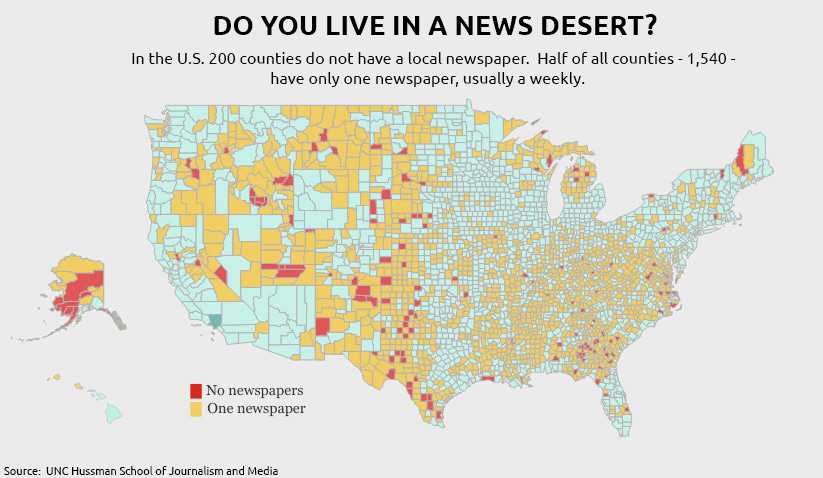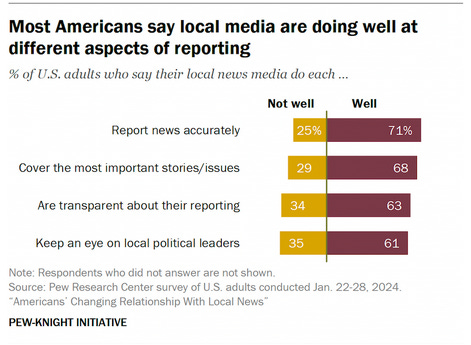The Impact of Local News Deserts
While Trump's national popular vote margin was just under 1.5%, his margin in news deserts was massive. What does this mean for democracy? Student newsrooms should be a part of the solution.
As an advisor to a local community college student news website, I have seen the power of community journalism first hand and the thirst that people have within the local community to be connected somehow. Some of this disconnect and lack of community stems from the lack of local news outlets. This lack of local journalism has resulted in news deserts across the country.
What are news deserts?
According to the University of North Carolina’s Center for Innovation and Sustainability in Journalism, a news desert is
a rural or urban community with limited access to credible and comprehensive news and information that feeds democracy at the grassroots level.
Here is a video that also defines it:
How big is this problem?
In 2024, the Medill School of Journalism at Northwestern University released a report that found that 1,561 counties in the United States had only one local news organization (e.g., print newspaper, news website, public broadcaster, or ethnic media outlet) while 206 counties had none, that 55 million Americans lived in news desert counties, and that news desert counties had lower median household incomes, lower rates of educational attainment, a higher median population age, and higher poverty rates.
According to a Pew Research study, Americans still value local news and journalists. A large majority say local news outlets are at least somewhat important to the well-being of their local community. Most people also say that local journalists are in touch with their communities and that their local news media perform well in several aspects of their jobs, such as reporting the news accurately.
At the same time, a relatively small share of Americans (15%) say they have paid for local news in the last year. And many seem unaware of the significant financial challenges facing local news: A 63% majority (albeit a smaller majority than in 2018) say they think their local news outlets are doing very or somewhat well financially.
Despite these positive views toward local news organizations, there are signs that Americans are engaging less with local journalism than they used to. The share of Americans who follow local news closely has fallen by 15 percentage points since 2016 (from 37% to 22%). Most U.S. adults still say they follow local news at least somewhat closely (66%), but this figure also has dropped in recent years.
Americans who feel a strong connection to their community are likelier to engage with local news, say that local news outlets are essential to the community, and rate local media more highly overall. For example, 66% of those who say they are very attached to their community say local news outlets are extremely or significant to the well-being of their local community, compared with 46% of those who are somewhat connected and 31% of those who are not very or not at all attached to their community.
Why is local news important?
Just as all politics is local, all news that matters is ultimately local. Strong newspapers put issues that may seem national into local contexts, such as healthcare, gun control, unemployment, or the opioid crisis.
As Al Cross, Director of the Institute for Rural Journalism and Community Issues at the University of Kentucky, has said,
“A good local newspaper shows you how you’re related to people you may not know you’re related to… I tell editors constantly that the readers of your county are not just residents of a county but of a region, a state, and a nation.”
The American Journalism Project explains that the loss of local news has an insidious effect on our democracy — contributing to polarization, a decrease in voting, and government accountability. Local news is essential to a healthy democracy; it helps communities understand what’s at stake in local elections. It equips them to get involved in the political process by voting, contacting officials, and running for office, reduces political polarization, and holds public officials accountable. Local news bridges divides within communities, showcases opportunities for community connection, highlights community perspectives, and illuminates how policy issues affect readers and their neighbors.
How did news deserts impact the 2024 election?
The third annual State of Local News report, released by Medill’s Local News Initiative in October, documented the continuing decline of local news across the country, as measured by the number of newspapers, circulation, frequency of publication, employment, and readership.
The report found that the highest concentration of counties with limited access to local news was in solidly “red” states, such as Texas, Kentucky, Arkansas, Idaho, Montana, and Mississippi.
Trump’s dominance of news deserts doesn’t necessarily mean they are correlated. Meaning that people didn’t necessarily vote for Trump because they lacked local news. Instead, a more obvious correlation may be to explain: News deserts are concentrated in counties that tend to be rural and have populations that are less educated and poorer than the national average–precisely the kind of places that went strongly for Trump in 2024 and in 2020.
However, news deserts can potentially affect voting behavior in other significant ways. When voters do not have local news, they tend to gravitate toward national news sources, according to research by Joshua P. Darr, a professor of public communications at Syracuse University. This kind of news, by definition, focuses on broad national issues—abortion, immigration, the economy, etc.—without regard to local conditions.
Imagine that you are only exposed to national news. In that case, you will be unlikely to know politicians' actions or plans for your state or the things that have been done to help your state (for example, all of the benefits of Biden’s infrastructure bill to local jobs and the economy). In that case, the only thing important to you is the candidate who shares your views on the significant national issues,” reinforcing basic partisan identity, he said.
What can we do?
According to The Poynter Institute for Media Studies (a non-profit journalism school and research organization), here are some suggestions:
Identify areas within each state without local news or in danger of losing it.
Designing policies and incentives at the state and national levels to address the disparity and availability of news in these communities.
Increasing — as well as redirecting — venture and philanthropic funding toward news organizations that seek to deliver reliable and comprehensive local news and information to residents in news deserts.
Rethinking journalistic practices to compensate for the dramatic loss of almost 60% of newspaper journalists in recent years.
Journalism Programs in local areas and student news
Student newspapers are beginning to fill in some of the gaps where there are news deserts. The Center for Community News at the University of Vermont led “the first nationally coordinated effort to strengthen university-led election coverage.” Around 145 colleges across 46 states participate in CCN’s Elections Cohort, including reporting programs and single professors leading small classes.
If schools are given proper funding, these programs can thrive. Thus, students can help build a local community and cover some of the local news that is fundamental to the areas in which they live, all while learning how to be fact-gatherers of the truth in the process. Press Forward is a national movement to strengthen communities by reinvigorating local news.
Press Forward partners are moving from individual grantmaking strategies to a shared vision and coordinated action. Press Forward is a national coalition investing more than $500 million to strengthen local newsrooms, close longstanding gaps in journalism coverage, advance public policy that expands access to local news, and scale the infrastructure the sector needs to thrive.
I was unaware of Press Forward's opportunities for local journalism programs, so I will apply for them with my students to try to expand this and help enhance journalism in the area where I live. I will keep you posted on the progress. (Additionally, I am working on another post about the importance of keeping journalism programs alive and well in our colleges nationwide.)
What are some of your suggestions for helping to decrease news deserts and create community-centered journalism in the place where you live?
If you cover a local beat here on Substack, I am collecting a list to write an article on local news substacks. Feel free to drop your info in the comments.💙✨







Michele - you’re terrific and I’m subscribing. I’m all about Press Forward!
Very insightful data here. I have created www.civiccapacity.com as a way to inform my friends and neighbors about the decisions local government are making here in my home county.